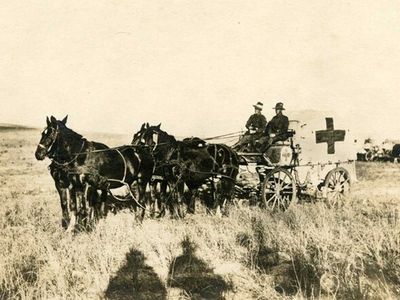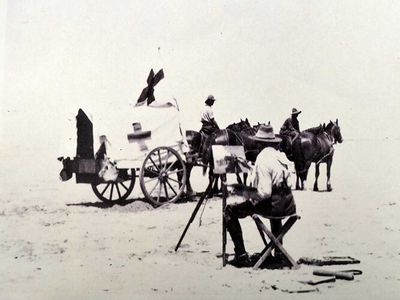“Major Avery, among many other Old Boys, holds a special place on the TGS Old Boys’ Wall of Achievement for his role in inventing the “Rapid Transit Ambulance” that was a key part of the Australian Light Horse Brigade.”

On ANZAC Day, we come together to reflect on the importance of service and sacrifice.
Toowoomba Grammar School would like to acknowledge our admiration for the loyalty, service and bravery exhibited by TGS Old Boys who so valiantly served. We are all the beneficiaries of their sacrifice, and their selfless actions continue to inspire a spirit of service amongst our current students.
Today we focus on the contribution of one TGS Old Boy who made a significant contribution to World War I. Here is some of the incredible story of Major Avery, DSO and if you visit the School Museum and Archives you can see a display in his honour.
Much of this history has been captured through countless hours of dedication and devotion by current TGS museum volunteer and former TGS staff member, Mrs Ann Hallam who managed the School’s Cadet Unit from 2006-2019.
Major Avery DSO, inventor of the WWI “Rapid Transit Galloping Ambulance”
Distinguished TGS Old Boy, Leonard Grimes (1880-1885) was born in Queensland in 1869 and died in 1953. Grimes attended the School in the days of Sir Harry Chauvel and Sir Littleton Groom and while at TGS was known as Leonard Avery Grimes.
After his School days he went on to Wadham College, Oxford, where he graduated with a medicine degree. He later changed his name to Conrad Avery and after some years as a hospital physician and surgeon, Avery enlisted with the British Army and joined the Suffolk Imperial Yeomanry. He was later promoted to Major and joined the Royal Army Medical Corps. During World War I he was enlisted with the Royal Westminster Dragoons and served in Palestine, Egypt and Syria.
Major Avery, among many other Old Boys, holds a special place on the TGS Old Boys’ Wall of Achievement for his role in inventing the “Rapid Transit Ambulance” that was a key part of the Australian Light Horse Brigade.
Light Horse Field Ambulance
The Light Horse units were mounted infantry with efficient mobile medical support to the wounded and sick soldiers of an Australian Light Horse Brigade. The Field Ambulance ensured the removal of the wounded from the front line to the advanced dressing station where there were surgical and resting tents.
These sand carts had two wheels with tyres that were wide enough to stop the cart digging into soft sand and could carry two or three stretchers. In heavy sand four horses were necessary to pull the cart, and the cart had to be steered by a rider on one of the lead horses.

Australian Light Horseman
The 2nd Light Horse Field Ambulance was formed in Brisbane with much of the unit coming from Queensland.
More than 15 TGS Old Boys enlisted with the Second Light Horse Brigade, two of whom died at Gallipoli: Major Dugald Maxwell Lockwood Graham and Trooper Gordon Holmes Robertson.
During the World War I, George W. Lambert (1873-1930) served Australia as an Official War Artist attached to the ANZAC Mounted Division. He spent two terms in service, the first with the Light Horse in Palestine, and the second in Gallipoli and Egypt before his military contract discharge.
As a result of Lambert’s service during World War I, he was offered a variety of commissions to paint scenes from significant war time events, including an activity of the 2nd Australian Light Horse Field Ambulance, Walk (An Incident at Romani).
The Battle of Romani was the last ground attack on the Suez Canal at the beginning of the Sinai and Palestine Campaign. The battle was fought from 3 to 5 August 1916 near the Egyptian town of Romani.
The completed painting was to be given to the Queensland (National) Art Gallery by the Light Horse in memory of their fallen comrades.
The Rapid Transit Ambulance
Major Avery describes his vision for a new galloping ambulance, known as “The Rapid Transit Ambulance”.
This ambulance was designed with a view to filling the want of stretcher bearers with mounted troops. The endeavor has been to construct a light strong carriage easily adjustable to any mounted horse and capable of keeping up with cavalry through any sort of country. As will be seen from the accompanying illustration, the ambulance is a two-wheeled contrivance.
The body consists of a platform fixed to a crank axle by long springs between 46-in. wheels. This platform is 2 ft. 3 in. from the ground and is arranged to carry an ordinary service stretcher. The forepart consists of a pair of short shafts which are attached to the body by an arrangement of springs adapted to prevent the side-to-side motion caused by the action of the horse. The shafts reach as far forward as the saddle flaps, where they are held in position by a girth strap, breastplate, and belly-band.
The body is covered by a canvas hood. The weight is about 3 cwt. Length overall, 12 ft. Track, 4ft. 1 in. Surgical dressings, splints, water-bottle, &c., are carried. It is quite easy for the driver, having placed a wounded or helpless man in a stretcher, to transfer him from the ground to the platform of the carriage single-handed.
This ambulance has been on duty with the Suffolk, Sussex, Surrey and Middlesex Imperial Yeomanry during their respective training, and with the Wiltshire Yeomanry through the recent maneuvers. It is a very comfortable conveyance and has proved capable of negotiating with almost any country.
Walk (An Incident at Romani)
The incident to which Lambert’s painting refers occurred during the Battle of Romani on 4 August 1916. The 2nd Light Horse Field Ambulance had deployed two sand-carts to an exposed part of the line to retrieve some seriously wounded men. Upon its return journey the Field Ambulance envoy came under Turkish fire and its panicked horses started to bolt.
Tragedy was averted when the corporal signaled ‘Walk’ and galloped to the front of the party to steady the teams. After the horses had been calmed and resumed their pace, the enemy apparently recognised the Ambulance’s mission and averted their fire. As a result of their bravery and composure during the incident the corporal and drivers were awarded Military Medals.

To enable Lambert to make sketches of the event that was already three years in the past, it was re-enacted at Kantara, Egypt in 1919. Photographs were taken of Lambert at work sketching this re-enactment. The completed painting portrays the moment when the corporal signals ‘Walk’ whilst rushing to the front of the group to steady the bolting teams.
Remembrance Day
Remembrance Day marks the anniversary of the Armistice which ended the First World War, signed at 11:00am on 11 November 1918. We still remember those who have given their lives in conflict before and since, by taking a minute to stop, be silent and remember the war that was to end all wars.
Latest Blog
Fostering Growth and Resilience
This philosophy is vividly demonstrated through our Junior School MATES program, an initiative designed to equip boys from Prep to Year 6 with the skills they need to thrive both in and out of the classroom. Year 6 leader Hugo Seaby epitomises what the program is all about. As a leader in Stephens House, he explains its importance: “It’s about spending time with the younger boys and learning about honesty, respect, kindness and other attributes like that.” He said that it’s helpful for the…
Preparing for the Future of Work
For months I have been watching the earthworks being undertaken ahead of construction for the new DET Centre at Toowoomba Grammar School with interest. It is hard to miss, given that the Headmaster’s residence, our family home, is right next to the building site. The vibrations can be unsettling, and the noises are constant. However, each day reminds me of the important work underway to secure a part of the School’s future. Soon, all boys at TGS will have the opportunity to immerse themselves…
“Watch your character, it becomes your destiny.”
Whether it was American essayist Ralph Waldo Emerson, Chinese philosopher Lao Tzu, or even UK Prime Minister Margaret Thatcher’s father who coined the phrase “watch your character, it becomes your destiny,” it was Dr Linda Evans who gave it real relevance to a theatre full of students, staff and families. After a decade and a half in charge of Toowoomba’s respected Fairholme College as Principal and some 22 years in total on staff, Dr Evans will leave the institution she has led and loved by…
Preparation for Boarding: Practical Tips and Tricks
In fact, I’ve coined the phrase “the clearer the runway, the smoother the landing” as a neat summary of this observation. A great deal of boarding experience can be initiated at home in the weeks and months leading up to your son’s departure, helping him prepare psychologically and logistically for his upcoming journey. At TGS, we acknowledge that the boarding journey for boys and families starts long before they enter the house in late January. In the mind of a new boarder and their family,…
Exploring the Role of Neuroscience in Supporting Teenage Boys
Recent insights from neuroscience reveal that the teenage brain undergoes significant changes, particularly in the frontal lobe, which is essential for decision-making, impulse control and emotional regulation. By leveraging this knowledge, we can create supportive environments that guide our boys through the complexities of their teenage years.The Prefrontal Cortex The prefrontal cortex, located in the frontal lobe, is one of the last areas of the brain to mature, significantly impacting…
Wellbeing and Character Development Program — Benefiting Students and Staff Alike
In 2024, the School re-established the Head of Pastoral Care position. The role will be pivotal in supporting all staff to foster a supportive and nurturing environment at Toowoomba Grammar School. Integral to the role’s success is the parallel expansion of the Wellbeing and Character Development (WCD) program to yield multifaceted benefits for both staff and students. For staff, the Head of Pastoral Care provides guidance, support and resources, aiding in their efforts to address students’…
Nurturing the Seeds of Leadership
Early exposure to leadership roles helps children develop character traits such as responsibility, empathy, resilience and integrity. As a School, we provide the opportunity for the cultivation of leadership skills in our young boys. From the formative years in Prep through to the adolescent years of Year 6, the importance of fostering leadership qualities cannot be overstated. In our modern world, where adaptability, resilience and initiative are regarded as quality attributes, nurturing the…
Pedal Power: The TGS Mountain Bike Club
What started with 12 boys now has 90, with many of the riders racing in the Schools Academy Gravity Enduro Series and other events. We also have a tour of 20 boys going to Thredbo in December this year, where they will tackle some of the most exciting trails in Australia. We thank the wonderful group of parents who support the club. They can often be found driving vehicles up and down the range on a Sunday morning to support the boys. We would not have been as successful as we are without…
Beyond the Blue and Gold
Our focus is to work with each individual student to assist in creating awareness of the world of work, helping students to articulate their interests and identifying what is important to them and their values. We assist the boys in developing the skills to explore the different careers out there. We connect them with employers and industry professionals and help them navigate towards the job or career they are interested in. We work hard to individualise each student’s unique School journey to…